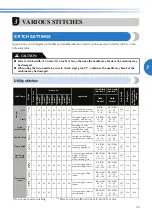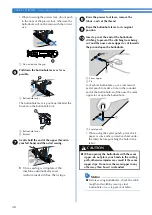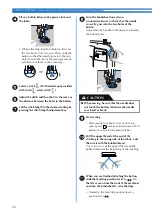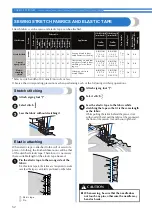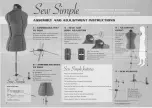
45
3
h
Remove the flat bed attachment and make
free-arm sewing possible.
• For details on free-arm sewing, refer to
“Using a free-arm style” (page 34).
i
Slide the part that you wish to sew onto the
arm, make sure that the fabric feeds correctly,
and then start sewing.
a
Arm
j
Position the fabric with the edge of the folded
hem against the guide of the presser foot, and
then lower the presser foot lever.
a
Wrong side of fabric
b
Fold of hem
c
Guide
k
Adjust the stitch width until the needle
slightly catches the fold of the hem.
a
Needle drop point
When you change the needle drop point, raise
the needle, and then change the stitch width.
a
Stitch width
■
If the needle catches too much of the hem fold
If the needle catches too much of the hem fold,
adjust the stitch width so that the needle slightly
catches the fold by pressing the “+” side of the
stitch width adjustment key.
■
If the needle does not catch the hem fold
If the needle does not catch the hem fold, adjust
the stitch width so that the needle slightly catches
the fold by pressing the “-” side of the stitch width
adjustment key.
• For details on changing the stitch width,
refer to “Selecting a stitch” (page 28).
l
Sew with the fold of the hem against the
presser foot guide.
m
Remove the basting stitching and turn the
fabric right side up.
R
R
1
a
a
Wrong side of fabric
b
Right side of fabric
a
Wrong side of fabric
b
Right side of fabric
a
Wrong side of fabric
b
Right side of fabric
1
2





